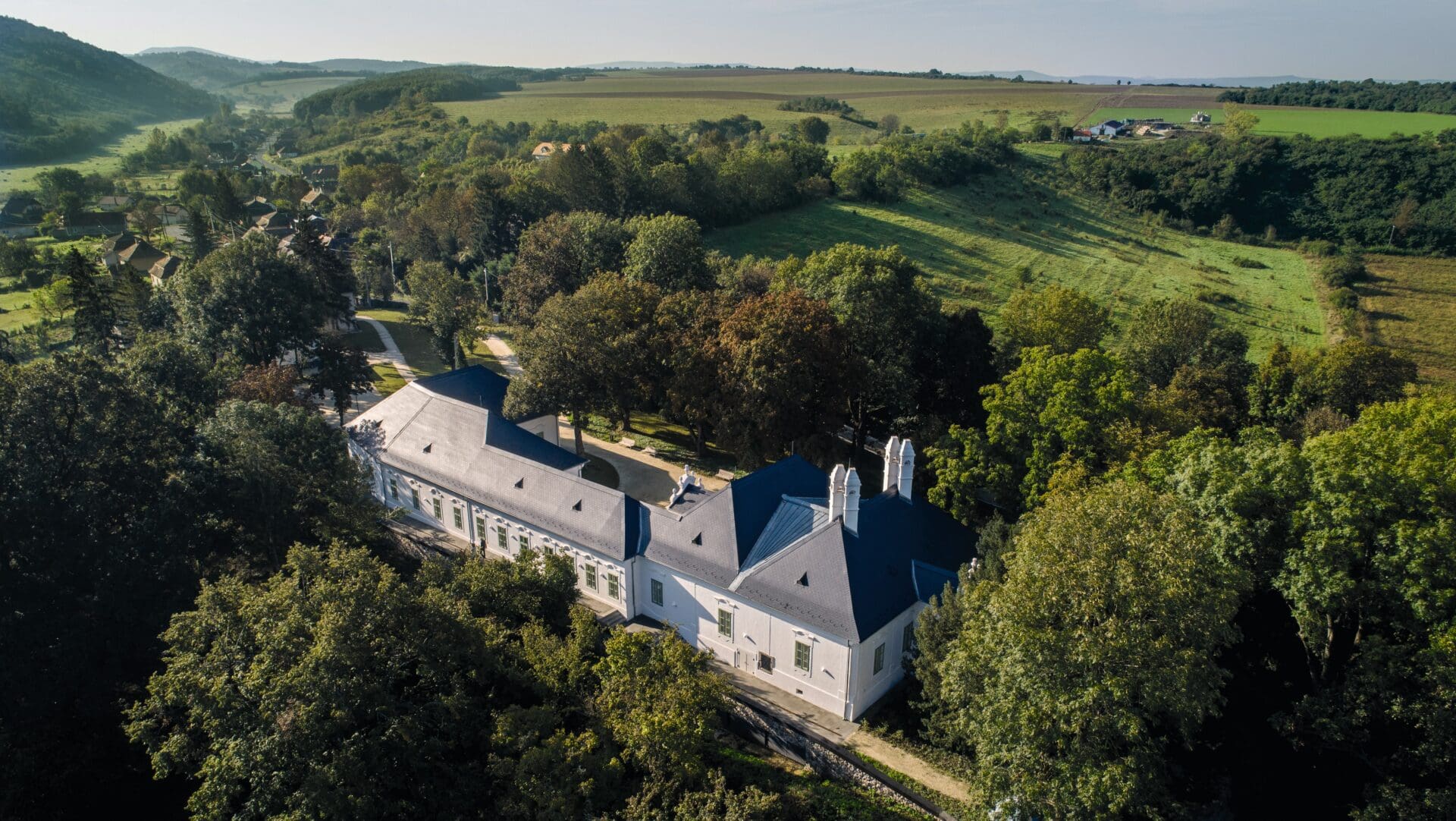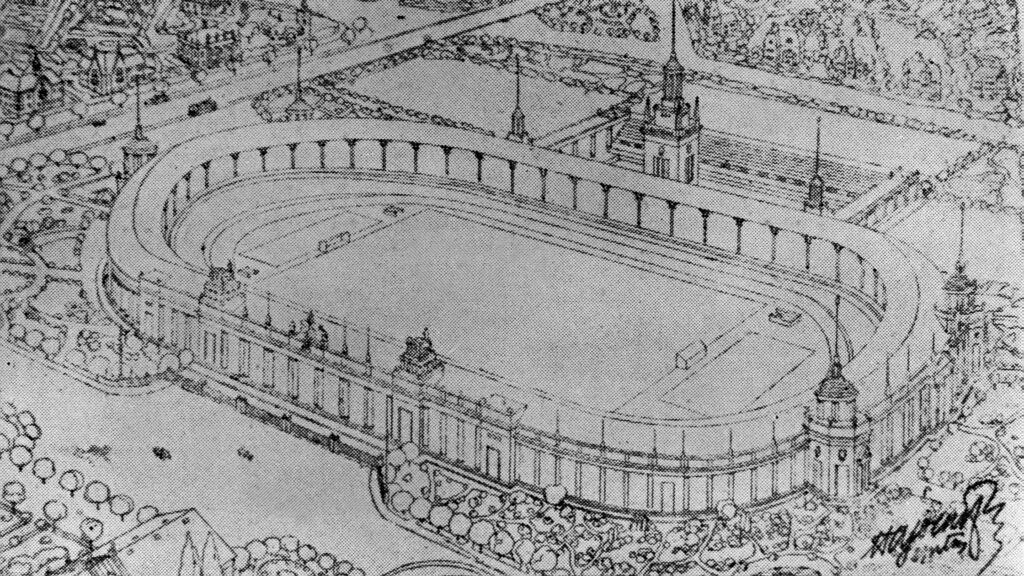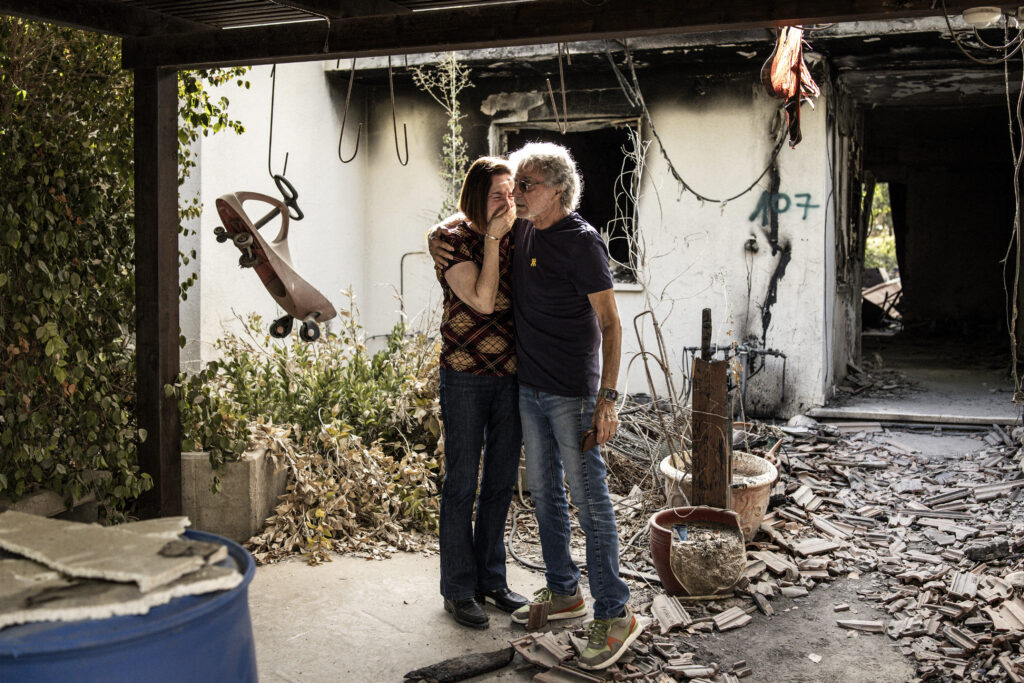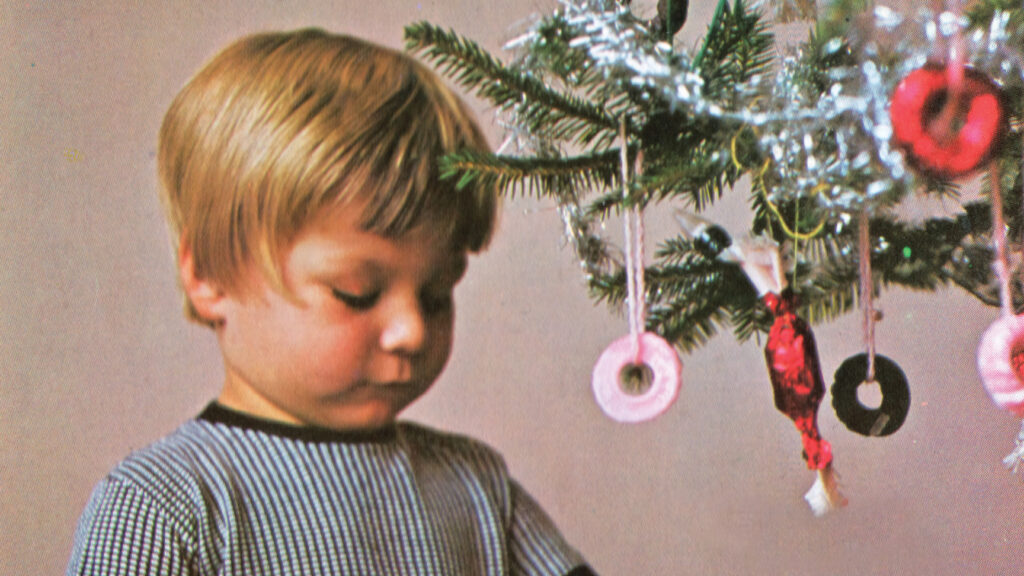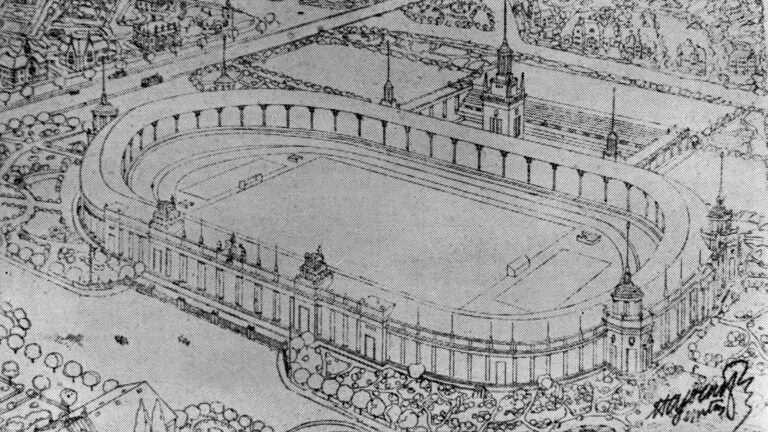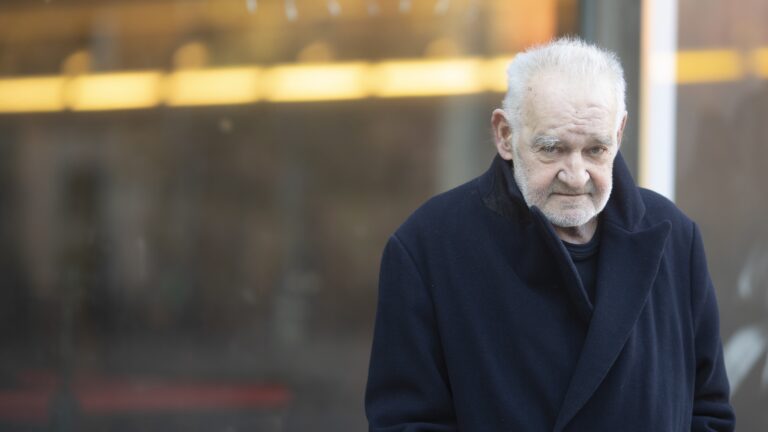The following is an article written by Orsolya Ferenczi-Bónis, originally published in Magyar Krónika.
Magyar Krónika recently visited the renovated former mansion of painter Gyula Benczúr, and the interactive exhibition The Picture Writer — Approaches to Gyula Benczúr it houses. The exhibition’s central aim is to reveal the artist’s less-known creative side. The magazine spoke with curator Evelin Páll to find our more about the building and the great Hungarian painter who owned it.
The former manor of the painter prince stands on a hilltop above the medieval village of Szécsény. In 1910, Gyula Benczúr bought the small estate with the building on it at the suggestion of his friend Kálmán Mikszáth, so that he could spend his summers with his family along the Ipoly river—the tiny settlement was called Dolány. In 1927, seven years after the painter’s death, it was renamed Benczúrfalva (meaning ‘the village of Benczúr’).
The single-storey late Baroque gabled wing of the castle was built by the Wattay family in the 18th century. The building later had several owners; Benczúr bought it from the Pejácsevich family. Count Endre Pejácsevich had the baroque wing connected with a glazed corridor, which housed the salons, to a separate part of the building, which, together with the service rooms and kitchen, became another wing of the small castle. The painter and his architect brother, Béla, had the purchased edifice decorated and an old granary converted into a mansard-roofed studio house a few steps away. After Benczúr’s death, his daughters ran a guesthouse in the mansion, then the building, looted after 1945, shared the fate of a typical Hungarian castle after the world wars, and in time came to the brink of collapse. However,
a three-year reconstruction project within the scope of the National Palace Programme brought it back to life from this almost incorrigible state.
The building on top of the park offers a magnificent view of the valley. The terraced gardens have been restored by landscape architects to preserve their wild beauty. Surrounded by huge trees—century-old yew trees, lindens, and an old oak named in honour of Rákóczi—, we are greeted by photographs of moments in the life of the Benczúr family when entering the edifice. The archival photographs, based on which the castle’s interiors were reconstructed, as well as documents, graphics, and a painting were lent to the exhibition by Benczúr’s great-grandchildren and great-great-grandchildren. The glazed corridor connecting the two wings of the manor opens onto the former dining room and the Paletta Café, which was once the mansion’s buffet. The floor is covered with monochrome Kelheim limestone in various shades, a stone popular in 19th-century castles—the restoration has taken great care to use authentic materials.
Gyula Benczúr, born in 1844, was a painter of the ‘glorious period of the Austro–Hungarian Compromise’. He studied with the most renowned teachers at the Munich Academy of Fine Arts, and after graduating from master school he taught there himself from 1876 to 1883. In 1883, he was called home by cultural politician Ágoston Trefort to become the director of the first school of painting—until then there had been no higher art education in Hungary, but the economic and cultural boom following the Compromise provided the background for the establishment of the institution. The exhibition titled The Picture Writer — Approaches to Gyula Benczúr begins with an audio installation that explores the positive and negative criticism of the painter’s art from both the academic and modernist worlds, showing what a turbulent and sometimes controversial period he lived through.
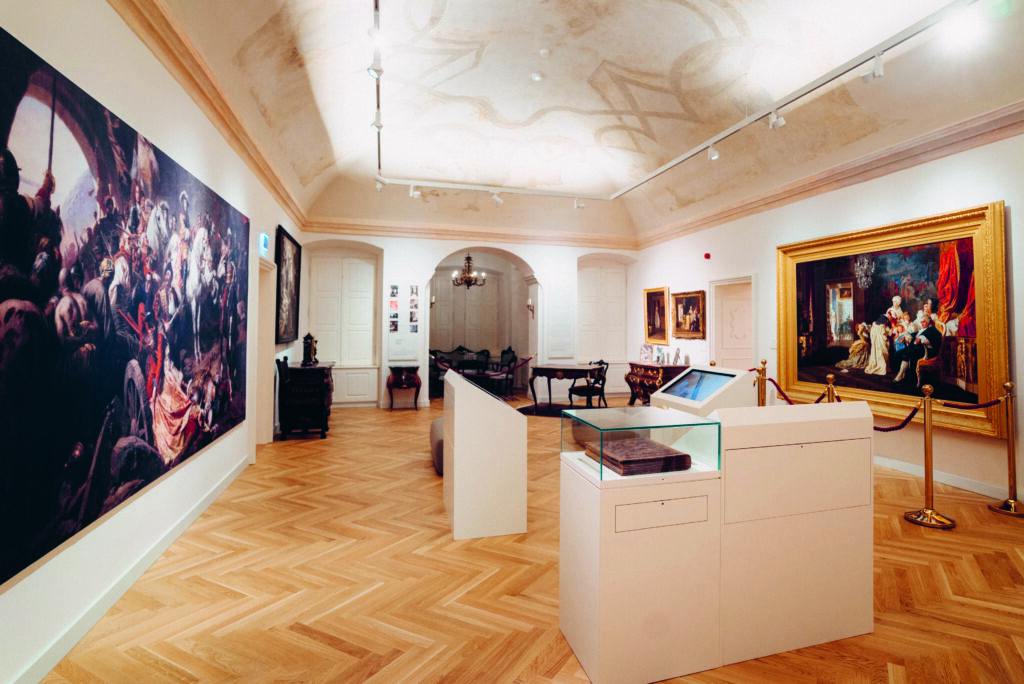
‘Picture writer’ is the old name for a painter, a term used by Benczúr for himself, even officially, for example when signing a contract of sale of an estate. ‘By choosing Gyula Benczúr’s self-definition as the main title of the exhibition, we want to draw visitors’ attention to the fact that the exhibition offers new approaches to his oeuvre through a “re-reading” of the works of art and primary written and pictorial sources,’ says curator Evelin Páll. The exhibition includes works that also allow us to get to know Benczúr as a private person, as well as those that link him to modern painting, realism, and naturalism. When we hear the painter’s name, we first envision his historical paintings such as The Baptism of Vajk (1875), László Hunyadi’s Farewell (1866), or The Recapture of the Buda Castle in 1686 (1896) and his representative portraits that form a significant part of his oeuvre—but as we walk through the exhibition, we can see that Benczúr had many different creative faces.
In the first room, we immediately meet not only the official painter Benczúr himself but also the artist who painted moments of intimacy, was sensitive to his models and self-portraits and depicted them in a direct way. ‘I wanted to nuance the extreme image of the official academic painter,’ explains Evelin Páll. ‘For example, in his pen-and-ink self-portrait of 1882, we see the unique man whose look, full of conflict, might as well be our own. Visual experiments of this extraordinary power, which overtly portray his inner struggles and anxieties, are also part of his oeuvre,’ she adds. In his later self-portraits, Benczúr hid behind masks as an academic painter, for example as pictor doctus, a scholar painter, or a former Turkish conqueror. The latter was painted in 1919, a year before his death when he was removed from the head of the master school during the Soviet Republic. ‘It is a powerful portrait, a particularly interesting choice by Benczúr,’ the curator says in front of the picture. ‘Historicism expresses the message of the present by evoking the painterly themes of past ages. Benczúr responded to the events of his life by choosing the roles for his self-portraits, too, often twisting the masks until it was difficult to find the simple and fallible man behind them:
the masks, the roles, became a means of distancing himself from himself,’
Evelin Páll recounts. This approach to existential questions returned in his art again and again—although neither his clients claimed this direction, nor did he follow it as an official painter, he had a creative face to it as well.
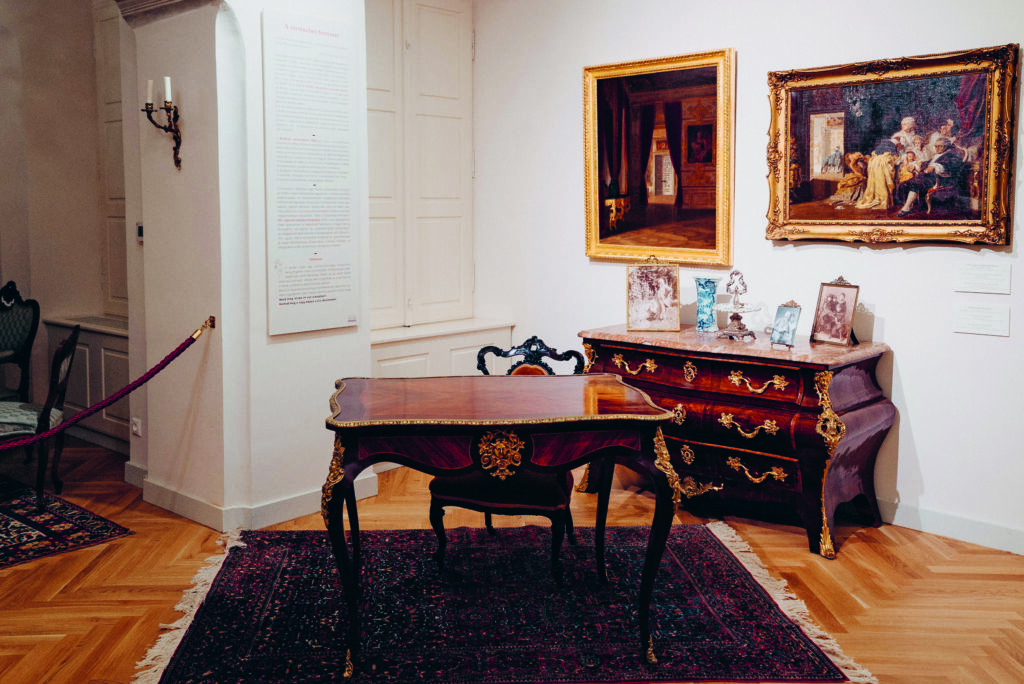
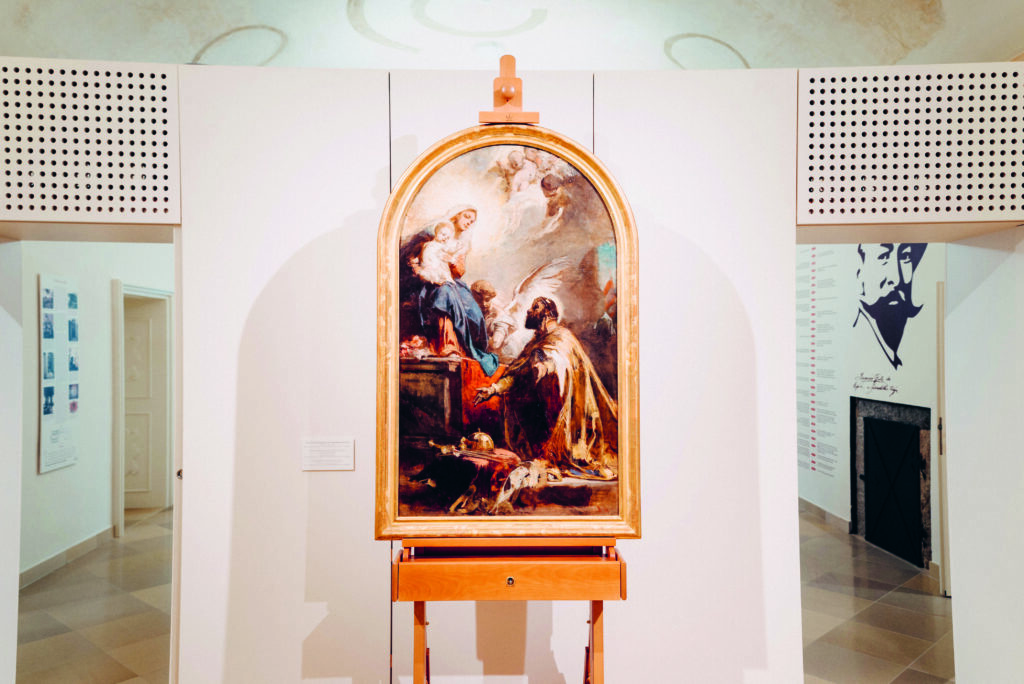
In the whole-wall installation in the Portrait and Representation section, we meet the official Benczúr: thirteen important pieces of his representative portrait painting are on display in the form of miniature reproductions. In addition to the ruling family, the nobility, leading politicians, and representatives of cultural life, he also painted the moneyed aristocracy, as everyone who mattered commissioned portraits from him. Benczúr’s representative works for the social public are imbued with both his extraordinary power of characterization and the distancing characteristic of 19th-century academic painting. However, there is an exception here too: in the original portrait of the extravagant, modern-minded Leó Lánczy, we find a direct, original portrayal of personality.
‘In the Faces of the Soul room, I wanted to show the hidden face of Benczúr through works that the painter did not create for the general public,’ continues Evelin Páll. The elderly peasant woman, painted with incredible power and empathy, the vulnerable craftsman, and the desperate mother with her children—graphics from the 1870s and 1880s show Benczúr’s sensitivity to social problems. ‘The fact that he is best known as a painter of beauty, monumentality, and grandiose national dreams does not mean that as a private man—and in his sketches and visual notes—he was not sensitive to themes of vulnerability, helplessness, misery, and intimacy,’ the curator adds.
These include the original oil paintings of Piroska Boldizsár Ürmössy, Benczúr’s second wife, and Mrs Alice Wahl Weiss, which, unlike the representative portraits in the previous room, were obviously made for private use. Their development is also quite different, with one or two layers of paint reminiscent of the artist’s oil sketch technique. This means that they were made quickly: the immediacy of the paintings confronts the viewer with the drift and emotions of everyday life. The artist captures on these canvases what touches him from ordinary life; an achievement of modern painting and a complete departure from academic painting. In this room, we can see fifteen portraits of Benczúr—twelve self-portraits and three copies of portraits arranged in an installation—from the earliest graphic, at the age of 17, to his last self-portrait, in which the painter of the glory of dualist Hungary is already facing life and passing away, having lived through the tragedy of the Great War and Trianon.
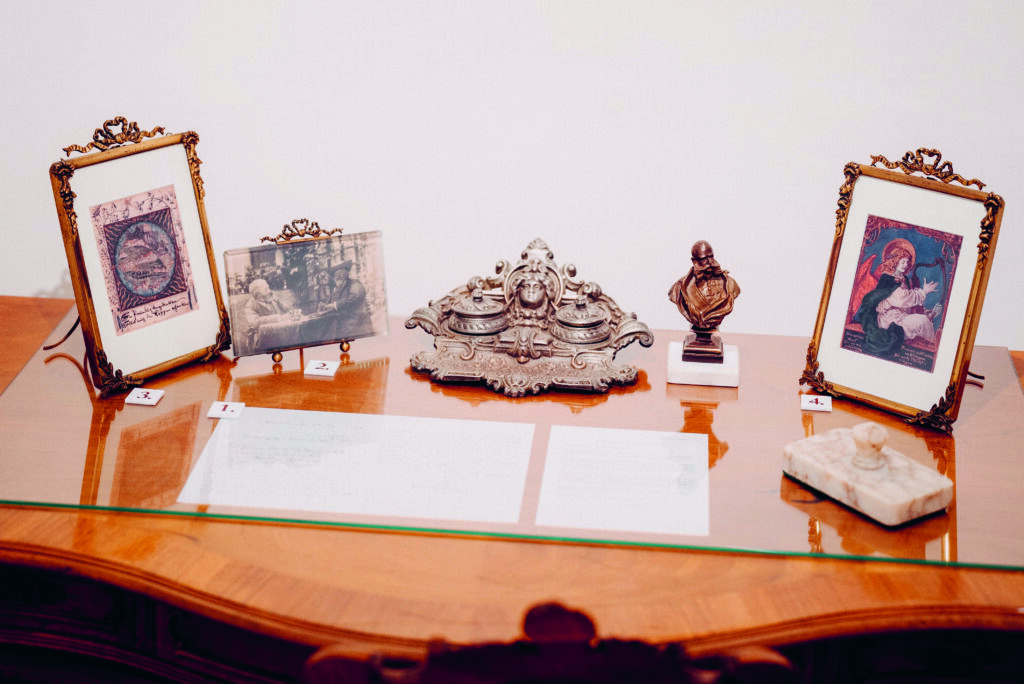
In the room dedicated to historical painting, visitors can see a miniature reproduction of the painting The Recapture of the Buda Castle in 1686, the monumentality and dynamism of which reflects the nation’s sense of self-consciousness and glory. On the other side of the room hang works of other genres of historical painting. A late Rococo life painting—an original work, returned to Hungary from America through the Hungarian National Bank’s commercial paper programme—depicts Louis XVI and his family at the moment before their capture at Versailles.
Benczúr’s historical paintings and representative portraits are characterized by astonishing materiality, with the silks, brocades, and damasks depicted seeming real. A separate table shows that the painter created a collection of three hundred textiles from 16th and 19th-century dresses and various pieces of fabric. Evelin Páll points out: ‘We have also received a series of graphics from descendants showing that Benczúr always drew a nude first and then dressed it methodically. Thus, the figures depicted, whatever clothes they wear, are impeccable from an anatomical point of view.’
His 1889 painting Among Mallows—a reduced, hand-made copy of the painting from 1897 is on display—was inspired by his children playing happily on holiday. This subject matter fits with his definition of painting: ‘it is only worth living for beauty’, and ‘art must please in order to give us beauty’—according to surviving sources,
Benczúr saw painting as a means of pleasure, as life is miserable and difficult enough.
One corner of the final room is reminiscent of the master’s library, and the interior is completed by an original table that Benczúr used in his studio in the ancient park of Epreskert. Another theme in the room is the painter’s relationship with realism and naturalism, with several naturalistic landscapes and depictions of the harmony between man and nature from the 1870s. One of his last paintings, an impressionistic landscape in the garden of his mansion, painted in 1920, the year of his death, is a unique piece in his oeuvre. After the loss of the Great War, the break-up of the country, and the Treaty of Trianon, Gyula Benczúr turned away from what he had been following his entire life and instead painted the garden surrounding his home. This is the first time the painting has been on display—until now even the art historical profession was unaware of its existence.
Related articles:
Click here to read the original article.

